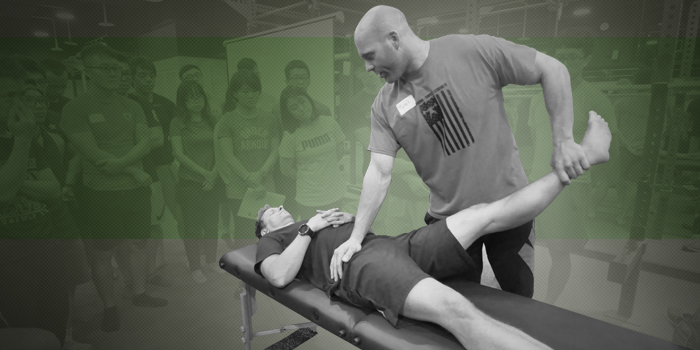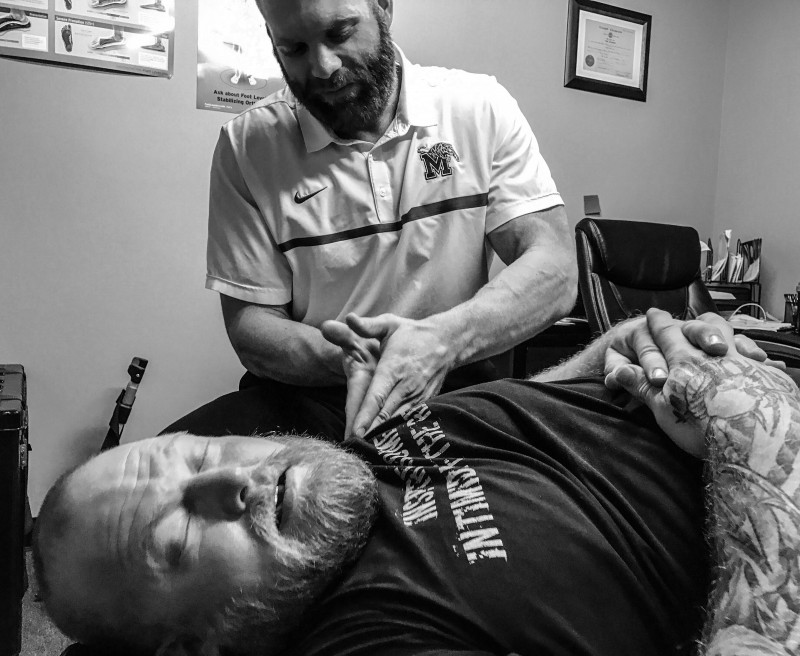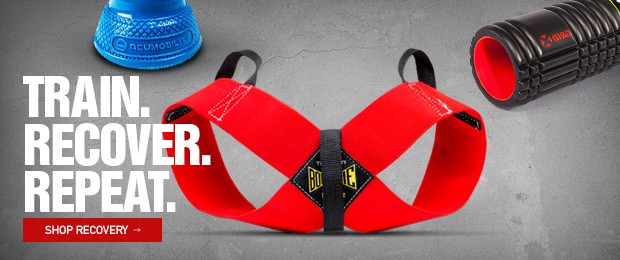
Over the past 11 years, I've been fortunate to gain experience as both an athlete and a physician in collegiate athletics at three separate schools. I’ve been able to work with hundreds if not thousands of collegiate athletes, and the biggest factor I’ve seen that determines the success of these athletes both at the collegiate level and beyond are the habits that are built toward recovery. My goal while working in college sports has always been to teach the athletes with whom I work to better understand how to take care of their bodies.
In my private practice, my vision is to create a practice that provides access to the tools and information necessary to help high school and amateur athletes to better understand and implement proper recovery habits earlier in their careers to help to promote personal responsibility and increased longevity.
A Dose of Reality
If you are a high school athlete—or a parent or coach of a high school athlete—and want to have a long career in sports, the quicker you understand the reality of the body, the better. Most kids and even their parents want to believe that they have the future laid out. Unfortunately, life does not always work that way. If you are unfamiliar with the probability of a high school athlete going on to play at the Division I collegiate level, only 1-2% percent high school athletes will accomplish this. After that, only another small percentage of that 1-2% will make it to the pros, and a smaller percentage of that will have long careers. But why?
What you need to understand is that the top two reasons an athlete walks away from a sport is that his or her body is too broken and injured to continue playing, or he or she isn’t good enough—which could also be due to too many injuries.
Back when I was a collegiate athlete at Iowa, a handful of guys in my class played as true freshmen. Two of these players were an offensive lineman and a middle linebacker. Both started multiple games as true freshmen and improved their standing on the team the following year as well. Both played in positions in which Iowa is highly regarded as having high-quality prospects for the National Football League (NFL). But before the beginning of our third camp, the middle linebacker decided to leave the team to move back closer to home.
The offensive tackle continued on to all Big Ten honors, became a first-round draft pick in the NFL, and won a Super Bowl. The middle linebacker beat out the linebacker, who left the team and went on to earn collegiate accolades before being drafted in the NFL. He even led the NFL in tackles for a year. Do I think the true freshman linebacker had a shot in the NFL? Absolutely. But that’s not always how it always goes.
The story doesn’t end there, though. Only one of these two players (the offensive lineman) are still in the NFL, and in his nine-year career, he has had only two injury-free seasons. The other, who was also plagued with injury at Iowa, had his one breakout year with the Indianapolis Colts before getting injured and then was unable to come back.
The moral of the story? Talent rarely determines how long your career will be, and one of the most common reasons that talent gets wasted is injury—not leaving the team, getting kicked off for conduct, or anything else. You must learn to respect and take care of your body if you expect to have a long career in any sport. I cannot tell you how many talented individuals I’ve seen who were never able to live up to their potential due to injury. I am still convinced to this day that the most freakish athlete I’ve ever seen who played as a tight end at Iowa would still be in the NFL and probably one of the top tight ends in the league had he not sustained an injury every year of his career.
In life, you cannot predict the future; you can only prepare as much as you can for it.
Image credit: Wavebreak Media Ltd © 123rf.com
Understanding Basic Recovery
In athletics, the act of moving, running, and other sport specific activities necessary to perform will damage and break the body down. This occurs during workouts, practice, competition, etc. Recovery is the term that describes the body’s response to this trauma that allows it to self-heal from this trauma and build itself back stronger and more resilient. The high school athlete needs to understand that recovery can do two things. Not only does recovery keep them from breaking down and getting hurt but also what builds them up and allows them to perform better.
However, some injuries are just an example of the unfair nature of life—wrong place, wrong time. You can make the argument that some sports, like football, are violent in nature and that some injuries in these sports just happen and aren’t under your control. This is true to some degree, as it is impossible to predict or prevent every roll-up knee injury or blindsided hit. Even with better equipment, safer rules, etc., there will always be injury. But most people’s understanding of the body and how injuries occur is superficial and incomplete.
Most athletes’ perception is that injuries like muscles strains, ligament tears, or joint pains just occur. The reality is that most injuries occur over time from wear and tear that compounds due to either a lack of recovery or improper movement patterns. When wear occurs on the muscles, soft tissues, or joints, fatigued. These tissues are weakened, fatigued, and sustain micro-trauma. Over time, this micro-trauma and fatigue builds. If recovery or proper movement is left unchecked, this damage continues to build until eventually the body can no longer sustain against the forces working against it in practice and workouts. When this threshold is reached, an injury occurs — but this injury could have been avoided had the athlete been recovering better.
MORE: Sleep Practices for Better Performance, Health, and Well-Being
The challenging thing about this example of recovery is that it is hard to perceive. It takes years of listening to your body to be able to understand the warning signs of sub-par recovery and then to know the correct actions to take to get back on track. This is why recovery is often neglected, and it is also why education is necessary. To help to better explain recovery to the young athlete, let’s use the most real example of recovery to which that they can relate—sleep. Sleep is the ultimate recovery tool, which is why every living being needs it.
To better understand the effects of improper recovery on the body, think about the last time you stayed up all night. How’d you feel the next day? Your body probably felt sluggish, and you likely made some mistakes or had trouble completing easy everyday tasks. The same problems occur gradually in the body when it is not recovering correctly. Your coordinated ability to react and produce forces begins to diminish and lag, which can lead to instability and excessive loading of the joints and soft tissues while you are performing simple tasks like squatting, running, or cutting.
Sleep deprivation is also cumulative. This means that even if you are undersleeping a few hours less than needed, the effects of doing this multiple nights in a row adds up to the equivalent of one or multiple nights without sleep. This is actually the more realistic kind of sleep deprivation in which chronic lack of sleep hinders recovery. The same is true for all recovery on the body. If you are constantly in a recovery deficit, this will accumulate on the body over time as well. You need quality recovery just like you need quality sleep.
When your sleep quality and amount are good, you’ll wake up feeling refreshed and have energy throughout the entire day. Your mood will be better, and you will be able to focus on tasks better. When you are recovering properly, you will feel good going into your training, you will have plenty of energy at practice, and your ability to focus and perform on your position will be optimal. For these reasons, proper recovery allows the athlete not only to prevent and resist injury but also helps to increase performance.
Your Body is Your Biggest Asset—Invest in It
Ask any veteran the biggest piece of advice he or she could give to a young athlete and I guarantee you he or she would answer, Take care of your body. What young athletes need to understand is that they have every ability to accomplish their goals in athletics, but to accomplish these goals, they need to protect their dreams by protecting their most important asset: their bodies. The quicker you can learn that, the better your chances of having a long career are.
I have seen far too many talented and determined athletes have their careers taken away from them due to injuries that could have been prevented or prolonged. If we could teach young athletes to value their bodies more and build recovery habits now before they have years of stress on their body, we would absolutely see fewer injuries at the collegiate level.
The cruel truth about athletics is that you never know when your time will be up, and very few people get to leave their particular sports on their own terms. For every Michael Jordan or Peyton Manning who goes out guns blazing atop the world as a champion, there are countless other athletes (Derrick Rose, Bo Jackson, etc.) who see their careers changed forever in the blink of an eye. And what about the athlete in his or her 30s and even 40s that somehow seems to stand the test of time? I guarantee that he or she spends just as much time—if not more time—investing in his or her body as he or she does preparing or practicing. Three years ago, Sports Illustrated released an article about Tom Brady's attention to his health. From diet to sleep, to time off and prehabilitation, there is insane detail in the methods that Tom Brady uses to keep himself healthy. Other pros have also become more open about the time and money they spend protecting their greatest asset. The amount of dedication to one’s body that is required to succeed should be exposed to young athletes. Our kids all want to go to a basketball camp to shoot and dribble like LeBron James can, but the best skill they could learn is to take care of their bodies as he does his own.
At the collegiate level, you can easily tell the upperclassmen from the lowerclassmen by how much time they spend in the athletic training room. Upperclassmen are usually in the athletic training room because they understand the importance of recovery or because they are hurt. Underclassmen typically bring no recovery habits in with them from high school, and they are either unaware of recovery or think they are Superman and don’t need recovery.
Eventually, one of two things will happen to these underclassmen. A veteran will take them under his or her wing and teach them the importance of being in the athletic training room and getting consistent treatment, or they will get hurt and learn the hard way. Another hard way to learn is when the pro teams come calling and the athlete who has been absent from the athletic training room his or her entire career suddenly realizes that his or her body is the ticket to a meal check and that he or she never spent one minute taking care of it and is riddled with injuries. Now, the biggest question coming in from his or her scouts isn’t even whether he or she can perform a task—it’s whether he or she will stay healthy enough. Make no mistake about it: Professional sports and much of collegiate sports are a business, and when a pro team signs a player, they are making an investment and expect a return on that investment. No one pays top dollar for a used car with high mileage.
So, for the high schooler, what can be learned from this? If you are serious about wanting to play at the next level, think of it as an investment. Building recovery habits is an investment in a future career. Just as in actual investing, the earlier you can begin, the more you can get out of the investment over time. Your body will not fall apart all in one day. It will break down slowly over time, and by the time you realize you need to invest, you have run out of time to get much return out of it.
WATCH: Must-Have Equipment for Any High School Weight Room
Learning to spend the time building proper recovery habits and seeking out professional help to identify your weaknesses will allow you to better achieve what all athletes eventually lust for: longevity. I know as a provider that if I get a young athlete who is injured, I have a chance to make an impact on his or her recovery habits. Pain is a huge motivator, and in athletes, losing the chance to compete is an even bigger one. So, I know I have a window of time in which I can persuade them of the importance of proper recovery habits.
On the other hand, I know that if I get a veteran player who is injured and has not spent much time in the athletic training room, I have a limited chance of instilling any good habits into him or her and thus protecting his or her career. It's simply a case of the amount of time an athlete has spent on investing in his or her body's longevity.
Imagine what would happen if we could help high school athletes to learn more about the importance of taking care of their bodies without them having to get hurt first. Couple this help with the execution of the concepts learned from their coaches and parents and we can have athletes making significant investments in their bodies now. They would already have a head start on doing things correctly.
The final takeaway is this: As a teenage high school athlete, you have a long path ahead of you before you generate true success in athletics. There are many others like you on this same path, and if you wish to continue on, you must be willing to do more than everyone else if you want to avoid falling off the path like all of the others have. Where others fail, you will have to succeed, and although many unknowns exist, rest assured that if you do not take care of your body, your chances of success will be severely diminished. Remember, there are right ways and wrong ways to do things. So, to those high school athletes, parents, and coaches out there asking, “Do I really have to worry about building proper recovery habits now?” If you are even remotely serious about playing your sport after high school—the answer is absolutely yes.













1 Comment